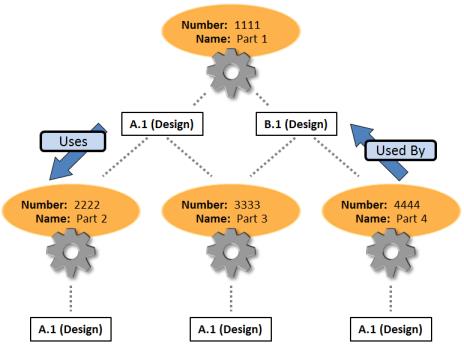Usage Relationships
The usage relationship describes the connection between a parent part (assembly) and child parts (components or subassemblies) in a part structure. There are two types of usage relationships:
• Uses—connects a specific assembly part version to the common data (or part master) of the child parts. The version-to-master connection makes it possible for different versions of an assembly part to use different child parts.
• Used by—Works from the opposite direction as the uses relationship. Following the used by relationship from a child part master to parent part version is extremely useful for analyzing the impact of part changes on products. The Where Used table captures the used by relationship to display all the assemblies that use a selected part. This information can help you determine the impact of a design change to a part on the assemblies that use it.
The following example illustrates the usage relationship between parts and the difference between the uses and used by relationships:

Following the part structure down from the assembly to the components shows the parts that an assembly version uses; following the part structure up the components to the assembly shows the assembly that a component is used by.
The best place to view usage relationships is on the Structure tab of a part information page. This dynamic part structure viewing and editing interface allows you to filter the part structure and expand usage relationships.
For more information, see Part Structure Information.
Important attribute information is also stored on the usage relationships between parts. This information includes:
• Quantity
• Line Number
• Find Number
• Units
• Trace Code
• Reference Designator
For definitions of these and other part attributes, see Part Attributes.